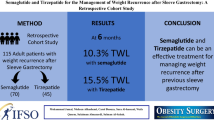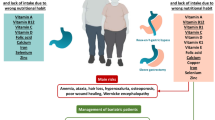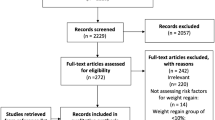Abstract
Background
Weight regain that begins 12–18 months after laparoscopic gastric bypass has been attributed to changes in resting metabolic rate (RMR), which is largely determined by lean body mass (LBM). An oral supplement containing beta-hydroxy-beta-methylbutyrate, glutamine, and arginine (HMB/Glu/Arg) has helped to restore LBM in cachexia due to cancer and in critically ill trauma patients. The objective of this study was to evaluate the effect of oral HMB/Glu/Arg on LBM and RMR following laparoscopic gastric bypass (LGB).
Methods
Patients who underwent LGB were randomized to receive 24 g of HMB/Glu/Arg dissolved in water twice daily for 8 weeks or to receive no supplement. Weight loss, LBM, and RMR were assessed preoperatively, 2 and 8 weeks postoperatively. LBM was determined by dual emission x-ray absorptiometry (DXA) and RMR was measured by indirect calorimetry.
Results
Thirty patients were enrolled: 80% white; 20% African American; 96.7% women; mean age 46.9 ± 8.4 years; mean weight 113.4 ± 11.6 kg; and mean body mass index (BMI) 43.3 ± 4.1 kg/m2. The experimental and control groups included 14 and 16 patients, respectively, and there was no difference in baseline demographics and characteristics between the two groups. At 8 weeks, weight, BMI, LBM, and RMR significantly decreased by 15.7 ± 2.5 kg, 6.0 ± 1.0 kg/m2, 7.8 ± 4.0 kg, and 290.6 ± 234.9 kcal/day, respectively (P < 0.0001 for each variable). However, when comparing these changes between the two groups, no statistical significance was observed.
Conclusions
There is a significant decrease in weight, BMI, LBM, and RMR in all subjects after LGB, and these changes were not affected by the use of HMB/Glu/Arg. Potential preservation of LBM as a result of HMB/Glu/Arg requires further investigation. However, its consumption (78 calories per serving) did not adversely affect weight loss in the experimental group.
Similar content being viewed by others
References
Sjostrom LV (1992) Mortality in severely obese subjects. Am J Clin Nutr 55:516S–523S
Centers for Disease Control and Prevention (2008) Prevalence of overweight, obesity and extreme obesity among adults: United States, trends 1976–1980 through 2005–2006. http://www.cdc.gov/obesity/data/trends.html. Accessed 15 Feb 2010
Centers for Disease Control and Prevention. (2008) Prevalence of overweight, obesity and extreme obesity among adults: United States, trends 1960–1962 through 2005–2006. http://www.cdc.gov/nchs/data/hestat/overweight/overweight_adult.htm. Accessed 9 Feb 2010
Strum R (2003) Increases in morbid obesity in the USA: 2000–2005. Public Health 121:492–496
National Heart, Lung and Blood Institute (1998) Clinical guidelines on the identification, evaluation, and treatment of overweight and obesity in adults—the evidence report. Obes Res 6(Suppl 2):51S–209S
Hinojosa MW, Varela JE, Parikh D, Smith BR, Nguyen XM, Nguyen NT (2009) National trends in use and outcome of laparoscopic adjustable gastric banding. Surg Obes Relat Dis 5(2):150–155
Cottam DR, Mattar SG, Barinas-Mitchell E, Eid G, Kuller L, Kelley DE, Schauer PR (2004) The chronic inflammatory hypothesis for the morbidity associated with morbid obesity: implications and effects of weight loss. Obes Surg 14:589–600
Must A, Spadano J, Coakley EH, Field AE, Colditz G, Dietz WH (1999) The disease burden associated with overweight and obesity. JAMA 282:1523–1529
Buchwald H, Avidor Y, Braunwald E, Jensen MD, Pories W, Fahrbach K, Schoelles K (2004) Bariatric surgery: a systematic review and meta-analysis. JAMA 292:1724–1737
Schauer PR, Ikramuddin S, Gourash W, Ramanathan R, Luketich J (2000) Outcomes after laparoscopic Roux-en-Y gastric bypass for morbid obesity. Ann Surg 232:515–529
Shah M, Simha V, Garg A (2006) Review: long-term impact of bariatric surgery on body weight, comorbidities, and nutritional status. J Clin Endocrinol Metab 91(11):4223–4231
Tacchino RM, Mancini A, Perrelli M, Bianchi A, Giampietro A, Milardi D, Vezzosi C, Sacco E, Marinis LD (2003) Body composition and energy expenditure: relationship and changes in obese subjects before and after biliopancreatic diversion. Metabolism 52(5):552–558
De Castro Cesar M, de Lima Montebelo MI, Rasera I Jr, de Oliveira AV Jr, Gomes Gonelli PR, Aparecida Cardoso G (2008) Effects of Roux-en-Y gastric bypass on resting energy expenditure in women. Obes Surg 18:1376–1380
Carey D, Pliego GJ, Raymond RL, Skau KB (2006) Body composition and metabolic changes following bariatric surgery: effects on fat mass, lean mass and basal metabolic rate. Obes J 16(4):469–477
Flancbaum L, Choban PS, Bradley LR, Burge JC (1997) Changes in measured resting energy expenditure after Roux-en-Y gastric bypass for clinically severe obesity. Surgery 122:943–949
van Gemert WG, Westerterp KR, van Acker BA, Wagenmakers AJ, Halliday D, Greve JM, Soeters PB (2000) Energy, substrate and protein metabolism in morbid obesity before, during and after massive weight loss. Int J Obes Relat Metab Disord 24:711–718
Sjostrom L, Lindroos AK, Peltonen M, Torgerson J, Bouchard C, Carlsson B, Dahlgren S, Larsson B, Narbro K, Sjostrom CD, Sullivan M, Wedel H (2004) Lifestyle, diabetes, and cardiovascular risk factors 10 years after bariatric surgery. N Engl J Med 351:2683–2693
Berk L, James J, Schwartz A, Hug E, Mahadevan A, Samuels M, Kachnic L (2008) A randomized, double-blind, placebo-controlled trial of a beta-hydroxyl beta-methyl butyrate, glutamine, and arginine mixture for the treatment of cancer cachexia (RTOG 0122). Support Care Cancer 16:1179–1188
Marcora S, Lemmey A, Maddison P (2005) Dietary treatment of rheumatoid cachexia with beta-hydroxy-beta-methylbutyrate, glutamine and arginine: a randomized controlled trial. Clin Nutr 24:442–454
Clark RH, Feleke G, Din M, Yasmin T, Singh G, Khan FA, Rathmacher JA (2000) Nutritional treatment for acquired immunodeficiency virus-associated wasting using beta-hydroxy beta-methylbutyrate, glutamine, and arginine: a randomized, double-blind, placebo-controlled study. JPEN J Parenter Enteral Nutr 24:133–139
May PE, Barber A, D’Olimpio JT, Hourihane A, Abumrad NN (2002) Reversal of cancer-related wasting using oral supplementation with a combination of [beta]-hydroxy-[beta]-methylbutyrate, arginine, and glutamine. Am J Surg 183:471–479
Kuhls DA, Rathmacher JA, Musngi MD, Frisch DA, Nielson J, Barber A, MacIntyre AD, Coates JE, Fildes JJ (2007) Beta-hydroxy-beta-methylbutyrate supplementation in critically ill trauma patients. J Trauma 62(1):125–132
Barbul A, Lazarou SA, Efron DT, Wasserkrug HL, Efron G (1990) Arginine enhances wound healing and lymphocyte immune responses in humans. Surgery 108:331–336
Yoshida S, Kaibara A, Ishibashi N, Shirouzu K (2001) Glutamine supplementation in cancer patients. Nutrition 17:766–768
Boza JJ, Turini M, Moënnoz D, Montigon F, Vuichoud J, Gueissaz N, Gremaud G, Pouteau E, Piguet-Welsch C, Finot PA, Ballèvre O (2001) Effect of glutamine supplementation of the diet on tissue protein synthesis rate of glucocorticoid-treated rats. Nutrition 17:35–40
Cunningham JJ (1980) A reanalysis of the factors influencing basal metabolic rate in normal adults. Am J Clin Nutr 33:2372–2374
Garby L, Garrow JS, Jorgensen B, Lammert O, Madsen K, Sorensen P, Webster J (1988) Relation between energy expenditure and body composition in man: specific energy expenditure in vivo of fat and fat free tissue. Eur J Clin Nutr 42:301–305
Nelson KM, Weinsier RL, Long CL, Schutz Y (1992) Prediction of resting energy expenditure from fat-free mass and fat mass. Am J Clin Nutr 56:848–856
Das SK, Roberts SB, McCrory MA, Hsu LK, Shikora SA, Kehayias JJ, Dallal GE, Saltzman E (2003) Long-term changes in energy expenditure and body composition after massive weight loss induced by gastric bypass surgery. Am J Clin Nutr 78:22–30
Murphy KG, Bloom SR (2006) Gut hormones and the regulation of energy homeostasis. Nature 444:854–859
Dulloo AG, Calokatisa R (1991) Adaptation to low calorie intake in obese mice: contribution of a metabolic component to diminished energy expenditures during and after weight loss. Int J Obes 15:7–16
Valtuena S, Blanch S, Barenys M, Sola R, Salas-Salvado J (1995) Changes in body composition and resting energy expenditure after rapid weight loss: is there an energy-metabolism adaptation in obese patients? Int J Obes Relat Metab Disord 19:119–125
Acknowledgments
The nutritional supplement containing HMB/Glu/Arg was provided by Abbott Laboratories, Illinois, U.S.A. The authors acknowledge the support of Dr. Barbara Gower, Director, Human Physiology Core, Diabetes Research and Training Center, UAB for her assistance with dual-emission X-ray absorptiometry. The Human Physiology Core, Diabetes Research and Training Center, UAB is supported by grants provided by National Institute of Diabetes and Digestive and Kidney Disease (P30 DK56336 and 1P60DK079626) and National Center for Research Resources (UL 1RR025777).
Disclosures
This study was supported by a research grant (F061211001) provided by Abbott Laboratories, Illinois, U.S.A. The authors, Dr. Ronald H. Clements, Neha Saraf, Manasi Kakade, Kishore Yellumahanthi, Merritt White, and Jo Ann Hackett have no commercial associations that might be a conflict of interest to this study.
Author information
Authors and Affiliations
Corresponding author
Rights and permissions
About this article
Cite this article
Clements, R.H., Saraf, N., Kakade, M. et al. Nutritional effect of oral supplement enriched in beta-hydroxy-beta-methylbutyrate, glutamine and arginine on resting metabolic rate after laparoscopic gastric bypass. Surg Endosc 25, 1376–1382 (2011). https://doi.org/10.1007/s00464-010-1371-9
Received:
Accepted:
Published:
Issue Date:
DOI: https://doi.org/10.1007/s00464-010-1371-9




